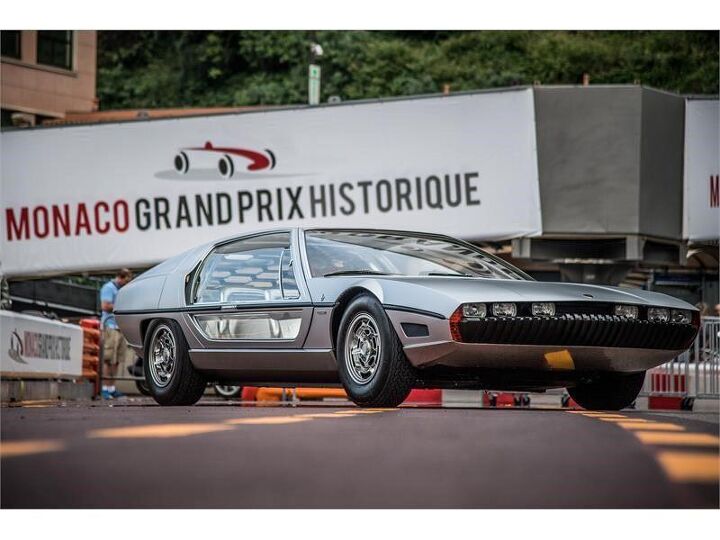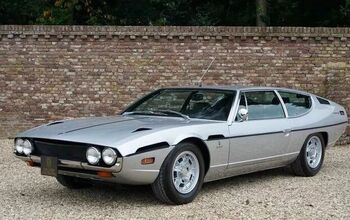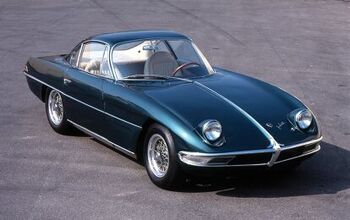Rare Rides Icons: Lamborghini's Front-Engine Grand Touring Coupes (Part VI)

We pick up our Lamborghini front-engine grand touring coverage at a time of design disappointments. Though the exotic Miura gave the company instant notoriety as it simultaneously created the super car class, the company’s other model was due for replacement. A more traditional looking two-door, the 400GT 2+2 was an edit of the 400GT Interim (2+1), which was itself an engine upgrade on the 350GT, the company’s first production car.
Ferruccio Lamborghini anticipated the need for a new design, and went in search of a 400GT replacement around the time it entered production in 1966. Lamborghini turned first to Carrozzeria Touring. But even though they penned the 350GT and 400GT designs, their two-seat shooting brake suggestion, Flying Star II, was not to Lamborghini’s taste.
In fact it was sort of like Touring didn’t read the prompt. An abandoned race car design called the 400GT Monza from Neri & Bonacini was also presented as an option. The firm built Lamborghini’s tube frames a few years before, but that didn’t lend them enough goodwill at Lamborghini to get their design accepted. Time for take three!
Time advanced to 1967, and the 400GT was in the middle of its production run. Lamborghini was willing to give another big name a shot: Marcello Gandini. Employed at Bertone at the time, Gandini took the four-seat grand touring directive more to heart than Carrozzeria Touring, but went even more wild everywhere else.
The basis for the new design was not the 400GT: Gandini chose the Miura’s chassis instead. It was lengthened by 4.7 inches overall (for a total of 103 inches), and strengthened considerably - a necessity with the lack of metal on the body. In finalized form, the body was 175 inches long, 67 inches wide, and only 43 inches high. With the exception of its overall height, the other dimensions were fairly similar to the extant 400GT.
What Gandini drew up was a wedge-shaped sports coupe with an enormous greenhouse, and very angular styling. The front end featured a heavily ribbed black bumper that terminated at large amber indicator lenses that were vertical, and integrated into the fender. Above there were six separate sealed beam headlamps, all square in shape.
The sharp front end featured a razor-thin hood line with no visible opening (it was a clamshell that opened from the A-pillar). The wide, flat hood had little detailing, and a sharp crease on either side that formed the upper half of the fender. A black trim strip went horizontally down the side of the coupe, and formed the shut line for the large hood.
A lower fender vent in front of the front tire was joined by a Bertone logo and model name, Marzal aft of the tire. The coupe’s side profile was dominated by a large glass area, interrupted only by the black piece of trim that allowed for door handle placement. The radical side profile included upper and lower panes of glass, set into a hexagon-shaped gullwing door.
The door frame itself formed the majority of the very fast A-pillar, which made for an enormous front windshield. There was no B-pillar, but the C-pillar was very thick and formed of a single piece of metal with the rear fender. It made for a flying buttress, but that design detail was covered by a honeycomb piece of black trim that concealed the true location of the vertical rear window.
The Marzal sat on a set of custom Campagnolo wheels, made of magnesium and with a hexagonal design theme. They measured 14 inches in diameter, and 6.5 inches wide. Tires specced were Pirelli Cinturato HS, 205-14s.
At the rear, the sharp character lines on the fenders drew up into an almost vertical fascia. There was a similarly ribbed bumper to the front end, along with typically Italian trapezoidal tail lamps.
A black mesh grille texture was added to the rear fascia and around the lamps. Underneath, a visible radiator was tucked under the lower valance, which provided cooling and a hint at where the engine was placed.
The interior of the Marzal was similarly wild, and played with the honeycomb theme present across the rear window. The silver exterior finish was contrasted by a two-tone blue and silver interior: The dash and pillars were covered in blue leather, while everything below the dash line was covered in metallic silver material. Speedometer and rev counter were a single hexagon shape, and set into a pod on the dash.
The rearview mirror was mounted from the dash on a stalk.
The honeycomb theming was replicated on the speakers, as well as in the center cluster where there were small auxiliary dials set into hexagons. Buttons and switches were mounted on the center stack, in multicolored plastic hexagons of their own.
Not content with the large side and front glass, there was also a large sunroof on the Marzal - at least it was tinted. In total, the coupe used 48 square feet of glass panel. The whole interior lounge was filled with light from the massive windows, and your author speculates a hothouse effect would occur even in winter. An air conditioning system was installed to prevent passengers from exiting as roasted chickens.
The finished Marzal was rear-wheel drive, and had its engine at the rear like a 911. Hardly the more conservative grand tourer Lamborghini specified, it also used a radical engine design: a 2.0-liter inline-six. The engine was reported to make 175 horsepower, and was developed by Gian Paolo Dallara. In essence, the 2.0 was half of the company’s 4.0-liter V12. Mounted transversely behind the rear passengers, it hung out over the rear axle.
Gandini’s design (like most of the things he penned) received immediate acclaim when it debuted in 1967 at the Geneva Motor Show. The radical approach to a four-seat sports car especially impressed Road & Track who declared the design was “...so fresh that everything else looks old fashioned.”
It’s at this point where the purpose of the Marzal is a bit unclear, and varies depending upon who’s providing the information.
Some sources indicate the coupe was intended to be a legitimate replacement for the 400GT, while others suggest it was just a fun design exercise. Perhaps Lamborghini asked for a legitimate GT replacement but was surprised by the results. At the time, he told Automobile Quarterly that the Marzal was just for show. “The Marzal was not developed as a production car. If you present a car like the Marzal at automobile shows… all the magazines report on the first page about it.”
Lamborghini went on to assert that it was better, and more affordable PR to “...build such a throwaway car” than to launch a traditional marketing campaign. Make your own call as to the intent behind the Marzal’s creation, but if it was just a fun design exercise Lamborghini certainly left choosing a production design down to the wire.
In any case, the Marzal remained a one-off concept, and Lamborghini moved on to a fourth 400GT replacement idea. Gandini’s design made an impact on Ferruccio, and he would return to Bertone in short order with another design request. Meanwhile, there was still the problem of the 400GT’s replacement. More next time.
[Images: Lamborghini]

Interested in lots of cars and their various historical contexts. Started writing articles for TTAC in late 2016, when my first posts were QOTDs. From there I started a few new series like Rare Rides, Buy/Drive/Burn, Abandoned History, and most recently Rare Rides Icons. Operating from a home base in Cincinnati, Ohio, a relative auto journalist dead zone. Many of my articles are prompted by something I'll see on social media that sparks my interest and causes me to research. Finding articles and information from the early days of the internet and beyond that covers the little details lost to time: trim packages, color and wheel choices, interior fabrics. Beyond those, I'm fascinated by automotive industry experiments, both failures and successes. Lately I've taken an interest in AI, and generating "what if" type images for car models long dead. Reincarnating a modern Toyota Paseo, Lincoln Mark IX, or Isuzu Trooper through a text prompt is fun. Fun to post them on Twitter too, and watch people overreact. To that end, the social media I use most is Twitter, @CoreyLewis86. I also contribute pieces for Forbes Wheels and Forbes Home.
More by Corey Lewis
Latest Car Reviews
Read moreLatest Product Reviews
Read moreRecent Comments
- Oberkanone How long do I have to stay in this job before I get a golden parachute?I'd lower the price of the V-Series models. Improve the quality of interiors across the entire line. I'd add a sedan larger then CT5. I'd require a financial review of Celestiq. If it's not a profit center it's gone. Styling updates in the vision of the XLR to existing models. 2+2 sports coupe woutd be added. Performance in the class of AMG GT and Porsche 911 at a price just under $100k. EV models would NOT be subsidized by ICE revenue.
- NJRide Let Cadillac be Cadillac, but in the context of 2024. As a new XT5 owner (the Emerald Green got me to buy an old design) I would have happy preferred a Lyriq hybrid. Some who really like the Lyriq's package but don't want an EV will buy another model. Most will go elsewhere. I love the V6 and good but easy to use infotainment. But I know my next car will probably be more electrified w more tech.I don't think anyone is confusing my car for a Blazer but i agree the XT6 is too derivative. Frankly the Enclave looks more prestigious. The Escalade still has got it, though I would love to see the ESV make a comeback. I still think GM missed the boat by not making a Colorado based mini-Blazer and Escalade. I don't get the 2 sedans. I feel a slightly larger and more distinctly Cadillac sedan would sell better. They also need to advertise beyond the Lyriq. I don't feel other luxury players are exactly hitting it out of the park right now so a strengthened Cadillac could regain share.
- CM Korecko Cadillacs traditionally have been opulent, brash and leaders in the field; the "Standard of the World".That said, here's how to fix the brand:[list=1][*]Forget German luxury cars ever existed.[/*][*]Get rid of the astromech droid names and bring back Seville, Deville, Eldorado, Fleetwood and Brougham.[/*][*]End the electric crap altogether and make huge, gas guzzling land yachts for the significant portion of the population that would fight for a chance to buy one.[/*][*]Stop making sports cars and make true luxury cars for those of us who don't give a damn about the environment and are willing to swim upstream to get what we really want.[/*][*]Stop messing around with technology and make well-made and luxurious interiors.[/*][*]Watch sales skyrocket as a truly different product distinguishes itself to the delight of the target market and the damnation of the Sierra Club. Hell, there is no such thing as bad publicity and the "bad guy" image would actually have a lot of appeal.[/*][/list=1]
- FreedMike Not surprisingly, I have some ideas. What Cadillac needs, I think, is a statement. They don’t really have an identity. They’re trying a statement car with the Celestiq, and while that’s the right idea, it has the wrong styling and a really wrong price tag. So, here’s a first step: instead of a sedan, do a huge, fast, capable and ridiculously smooth and quiet electric touring coupe. If you want an example of what I’m thinking of, check out the magnificent Rolls-Royce Spectre. But this Cadillac coupe would be uniquely American, it’d be named “Eldorado,” and it’d be a lot cheaper than the $450,000 Spectre – call it a buck twenty-five, with a range of bespoke options for prospective buyers that would make each one somewhat unique. Make it 220 inches long, on the same platform as the Celestiq, give it retro ‘60s styling (or you could do a ‘50s or ‘70s throwback, I suppose), and at least 700 horsepower, standard. Why electric? It’s the ultimate throwback to ‘60s powertrains: effortlessly fast, smooth, and quiet, but with a ton more horsepower. It’s the perfect drivetrain for a dignified touring coupe. In fact, I’d skip any mention of environmental responsibility in this car’s marketing – sell it on how it drives, period. How many would they sell? Not many. But the point of the exercise is to do something that will turn heads and show people what this brand can do. Second step: give the lineup a mix of electric and gas models, and make Cadillac gas engines bespoke to the brand. If they need to use generic GM engine designs, fine – take those engines and massage them thoroughly into something special to Cadillac, with specific tuning and output. No Cadillac should leave the factory with an engine straight out of a Malibu or a four-banger Silverado. Third step: a complete line-wide interior redo. Stop the cheapness that’s all over the current sedans and crossovers. Just stop it. Use the Lyriq as a blueprint – it’s a big improvement over the current crop and a good first step. I’d also say Cadillac has a good blend of screen-controlled and switch-controlled user interfaces; don’t give into the haptic-touch and wall-to-wall screen thing. (On the subject of Caddy interiors – as much as I bag on the Celestiq, check out the interior on that thing. Wow.)Fourth step: Blackwing All The Things – some gas, others electric. And keep the electric/gas mix so buyers have a choice.Fifth step: be patient. That’s not easy, but if they’re doing a brand reset, it’ll take time.
- NJRide So if GM was serious about selling this why no updates for so long? Or make something truly unique instead of something that looked like a downmarket Altima?









































Comments
Join the conversation
I've always liked the design of the Marzal. BTW, that's Prince Albert II of Monaco behind the wheel, at the 2018 Historic GP of Monaco. His father Prince Rainier III (along with the lovely Princess Grace) took it around the course for a parade lap in 1967, before that year's Monaco Grand Prix.
It's cool reading about how their cars were named. The Islero was named after a Miura bull (Miura bulls are bred for bullfighting) that killed a legendary matador in 1947.
Ah, one of my favorite Matchbox cars from the late '60's. Number 20, in a dark burgundy red if I recall correctly! I collected the cars (and still have them, in their original boxes), but when it came to exotic cars, I never knew anything about the actual cars themselves.